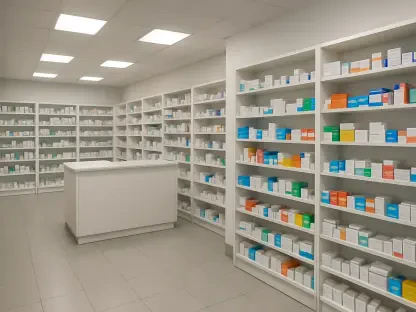Africa’s pharmaceutical market is on the cusp of a transformative era, projected to expand from USD 64.2 billion in 2025 to USD 118.3 billion by 2032, at an impressive CAGR of 9.10%. The surge in this sector is largely attributed to an increase in chronic disease cases, improvements in regulatory frameworks, and initiatives aimed at bolstering local pharmaceutical production. As urbanization rapidly progresses across Africa, lifestyle changes have inadvertently escalated the prevalence of non-communicable diseases. Consequently, there is an escalating demand for pharmaceuticals specifically curated to combat ailments such as diabetes and cardiovascular conditions. Driving this growth is the strategic alignment of regional initiatives like the Africa Medicines Regulatory Harmonization (AMRH) and the African Continental Free Trade Area (AfCFTA), both of which are crucial in expediting drug approvals and enhancing market access through streamlined processes.
Regulatory Harmonization and Market Access
Central to the burgeoning pharmaceutical market in Africa is the effort to harmonize regulatory procedures and enhance market access. The Africa Medicines Regulatory Harmonization (AMRH) initiative plays a pivotal role by aiming to unify drug registration standards across multiple African nations, thereby significantly reducing approval timelines. Alongside AMRH, the African Continental Free Trade Area (AfCFTA) facilitates seamless cross-border trade, enabling pharmaceutical companies to penetrate new markets swiftly and efficiently. These measures not only lead to quicker drug approval processes but also reduce costs related to redundant registrations in different regions. The harmonization strategy encourages pooled procurement, which helps in negotiating better prices, thereby making essential medications more affordable. It is crucial for pharmaceutical firms to adapt to these dynamics, seizing opportunities to market their products more broadly and rapidly across the continent. Furthermore, these regulatory shifts are not just advantageous for established pharmaceutical giants but also offer smaller, local companies a platform to expand and strengthen their market presence.
Local Production and Government Support
Boosting local pharmaceutical production is a significant focus as African governments pursue strategies to make medicines more affordable and accessible to their populations. This includes supporting technology transfer initiatives, such as those spearheaded by the African Pharmaceutical Technology Foundation, backed by the African Development Bank. The effort addresses Africa’s heavy reliance on imported pharmaceuticals, reducing dependency by fostering homegrown production capabilities. This drive not only enhances the continent’s self-sufficiency in medication supply but also stimulates local economies by creating jobs and building industry infrastructure. Additionally, leaders like Sanofi, Pfizer, and GSK are increasing investments and collaborations with local entities to bring cutting-edge pharmaceutical solutions to African markets. By investing in local manufacturing facilities and skill development, these multinational companies can contribute to elevating the quality and reach of healthcare services in Africa. Governmental policies, while supportive, must consistently evolve to streamline processes and provide incentives that attract more global and local investments into the sector.
Key Players and Future Prospects
As Africa’s pharmaceutical landscape evolves, key industry players continue to make significant contributions that drive growth and innovation. Major companies such as Sanofi, Pfizer, and GSK are leveraging their expertise to expand their footprints across the continent, focusing not only on market penetration but also on strategic partnerships with local businesses. These collaborations often result in technology transfer and skills development that further enhance local manufacturing capabilities. The African Pharmaceutical Technology Foundation backs these endeavors by facilitating smoother transitions of technology and knowledge from multinational to local pharmaceutical firms. This synergy is vital for reducing import dependency and promoting sustainable growth in the sector. Additionally, the future looks promising with continuous emphasis on regulatory frameworks and local production initiatives. As urbanization trends persist, a corresponding demand for healthcare products and services is expected, fostering an environment ripe for investment and innovation. The forecast for Africa’s pharmaceutical market in the coming years is thus an encouraging one, signaling substantial opportunities for stakeholders ready to align with its dynamic growth trajectory.
Conclusion: Embracing Opportunities in a Transformative Market
The growing pharmaceutical market in Africa focuses on harmonizing regulatory procedures and improving market access. The Africa Medicines Regulatory Harmonization (AMRH) initiative is essential, aiming to standardize drug registration protocols across numerous African countries, which in turn significantly cuts down approval times. In tandem with AMRH, the African Continental Free Trade Area (AfCFTA) enhances cross-border trade, making it easier for pharmaceutical firms to quickly enter new markets. These steps not only expedite drug approvals but also diminish costs linked to duplicate registrations in various regions. The harmonization process promotes pooled procurement, which aids in negotiating more favorable prices, thus making vital medications more accessible and affordable. Pharmaceutical companies must adapt to these changes, taking advantage of broader and faster market reach across the continent. Additionally, these regulatory changes benefit not just large pharmaceutical companies but also provide smaller local businesses the chance to expand and establish a stronger market presence.









